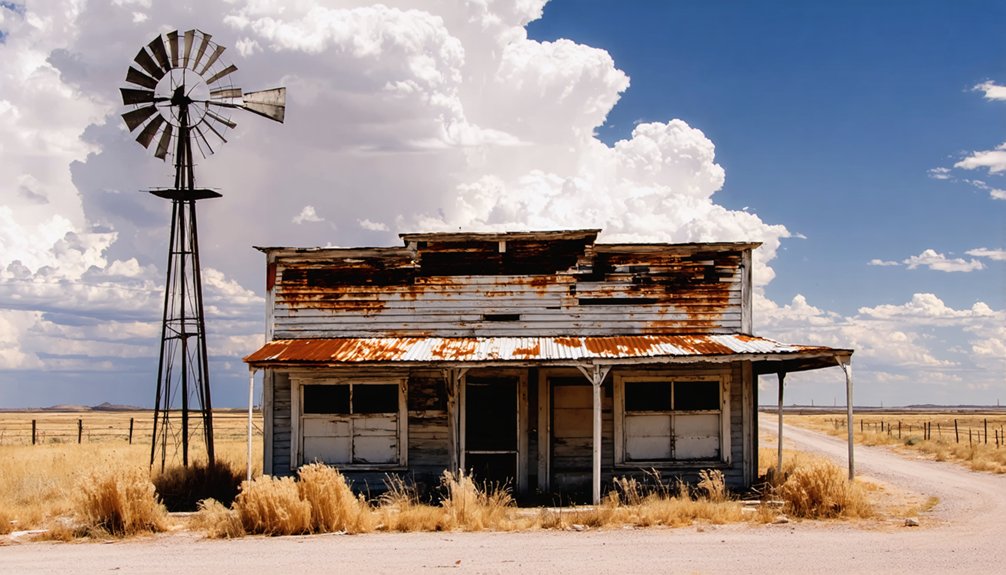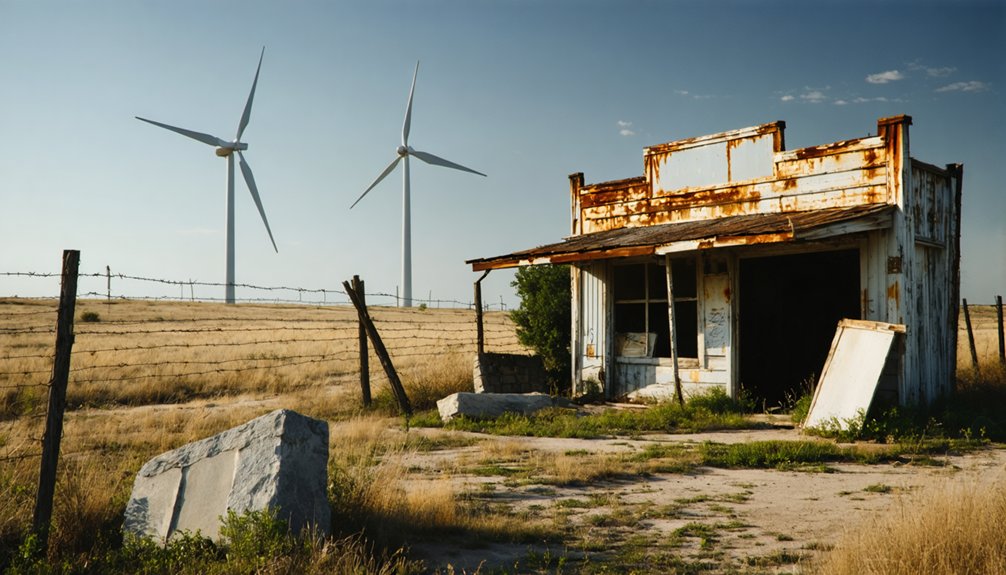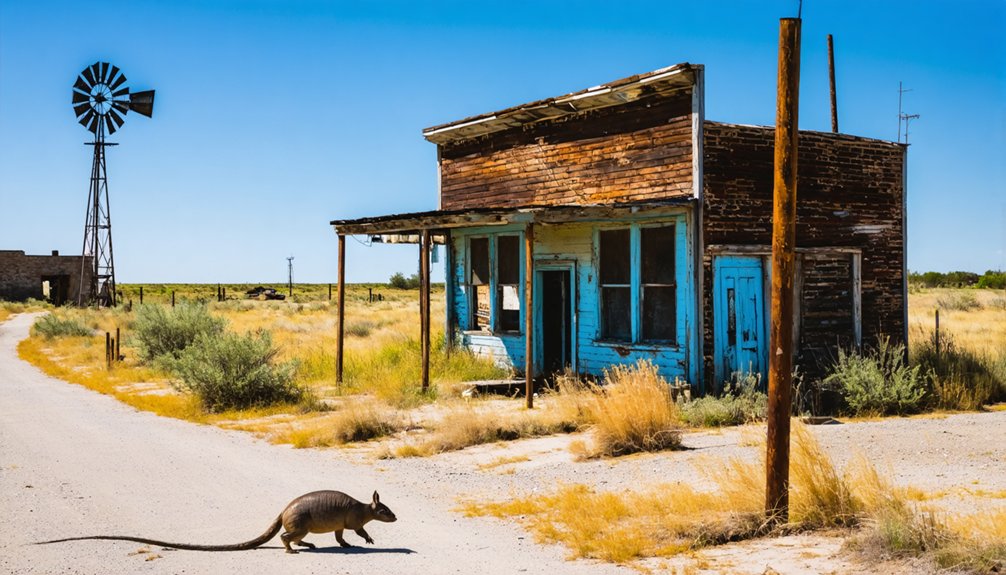You’ll find Decker’s haunting remains in southeastern Texas, where Isaac Decker established one of the region’s first settlements in the 1830s. The town flourished as a railroad stop and military site, particularly housing a Confederate powder mill during the Civil War. By the mid-20th century, economic shifts and rural exodus transformed this once-bustling community into a ghost town. Today, weathered limestone structures and abandoned railroad tracks tell stories of Texas’s boom-and-bust heritage.
Key Takeaways
- Decker transformed from a thriving railroad town in the late 19th century to a ghost town by 2000 due to economic decline.
- The town’s Confederate powder mill, established in 1861, suffered a catastrophic explosion in 1863 that killed three workers.
- Historical structures include weathered limestone buildings, adobe ruins, abandoned railroad tracks, and a cemetery containing early settler graves.
- The site began as Isaac Decker’s 4,428-acre land grant along Williams Creek, initially thriving through agriculture and railroad connections.
- The ghost town now attracts urban explorers and history enthusiasts, with limited preservation efforts focused on documenting local heritage.
Early Settlement and Pioneer Life
While Mexican land grants drew early pioneers to Texas in the 1830s, it was Isaac Decker’s settlement that established one of the region’s first permanent communities.
You’ll find that Decker, a Canadian shoemaker, received a substantial 4,428-acre grant along Williams Creek and the Colorado River, though pioneer struggles with Native American attacks forced his relocation to Montgomery County.
The community’s resilience emerged through strategic land management, as settlers like Decker balanced farming and ranching operations. His arrival in Texas led him to establish Decker Prairie settlement, which would later become part of the Greater Tomball area.
You can trace the foundations of community resilience in how these early pioneers adapted to frontier challenges, establishing self-sufficient homesteads that grew into villages.
The land’s natural resources, including oak and black walnut trees, supported their survival, while subsequent Swedish immigrants in the 1860s expanded the settlement’s cultural fabric. A notable development during the Civil War era was the establishment of a Confederate powder mill that served the southern cause.
Origins of the Decker Prairie Name
Although Isaac Decker originally settled near Williams Creek in Travis County, it’s his subsequent 177-acre land grant north of Spring Creek that gave Decker Prairie its enduring name.
You’ll find that Decker’s legacy lives on through this historic Texas community, which emerged from his pioneering settlement. His impact on the region’s development is preserved through:
- The community’s name itself, honoring his role as one of the earliest settlers
- Century-old oak and black walnut trees he planted near his homestead
- A granite historical marker commemorating his settlement
- The preserved land grant boundaries that defined Decker Prairie’s core
This Canadian-born shoe cobbler’s decision to relocate from Travis County due to Native American conflicts ultimately shaped the identity of what would become an important early Texas settlement. Like many early Texas settlements, the area saw significant development after the Missouri-Kansas-Texas Railroad expanded regional connectivity. The area experienced significant change when a Confederate powder operation exploded in 1863, killing three individuals.
The Confederate Powder Mill Era
During the tumultuous years of the Civil War, Decker Prairie became a strategic military site when Confederate forces established a powder mill along Spring Creek in 1861.
You’ll find that powder production occurred in a complex of buildings, including blacksmith shops and worker cottages, all powered by a massive waterwheel. The facility manufactured cannon powder and military supplies for Confederate troops, joining other mills across Texas in supporting the Southern war effort. Recent historical evidence suggests the mill was overseen by Janet Wagner, a national historian researching its operations.
The mill’s explosive legacy came to a tragic end in 1863 when a catastrophic blast killed several workers. William Bloecher, Adolph Hillegeist, and Peter Wunderlich were the three employees who lost their lives in the devastating explosion.
Today, you can visit memorial markers honoring three known victims of the explosion. After its destruction, the site returned to private ownership, but its significance in Confederate industrial history remains preserved through local heritage efforts.
Rural Education and Community Development
If you’d visited Decker’s one-room schoolhouse in 1907, you would’ve found two teachers managing sixty-one students across multiple grade levels, with children bringing their own books and helping tend the stove.
Like many frontier schools, students carried their lunches in lard and coffee cans and shared water from a communal dipper during their daily breaks.
Rural education in Decker evolved from this humble 1882 beginning into an essential community hub, where the schoolhouse doubled as a gathering place for local families and complemented the nearby Methodist church’s social functions.
The school’s 1943 consolidation with Manor Independent School District marked the end of Decker’s educational autonomy, reflecting the broader pattern of rural Texas communities losing their independent schools to larger districts.
Today, dedicated organizations work to preserve historical records of these vanished educational institutions, ensuring their stories remain part of Texas’s cultural memory.
Early Schoolhouse Operations
While many small Texas settlements struggled to establish formal education in the 1880s, Decker’s commitment to schooling emerged early with the opening of its schoolhouse in 1882. Modern genealogy resources help researchers trace the educational heritage of these early Texas communities.
The area’s first settler Isaac Decker received his land grant in 1835, establishing the foundation for what would become the Decker community.
This schoolhouse importance extended beyond basic education, serving as a crucial hub for community engagement among scattered rural families.
You’ll find the schoolhouse operations reflected the determination of early settlers through:
- Two dedicated teachers managing 61 students across multiple grade levels
- Flexible scheduling that accommodated local farming families’ seasonal needs
- Shared resources and donated supplies that kept the school functioning
- Regular community gatherings that strengthened bonds between rural households
The schoolhouse maintained its independent operations until 1943, when consolidation with Manor Independent School District marked the end of an era in Decker’s educational history.
Community Learning Evolution
As Decker’s educational landscape evolved beyond its original schoolhouse, the community faced mounting pressures that shaped its learning institutions between 1930-1950. You’ll find that economic hardships and declining rural populations forced Decker to adapt, joining the wave of school consolidations sweeping across Texas during this period.
The educational evolution brought both challenges and opportunities. Through WPA support, Decker’s curriculum expanded to include practical programs like agriculture and homemaking, reflecting the community’s changing needs.
The consolidated school became more than just classrooms – it emerged as a crucial hub of community identity, complete with new facilities like a gymnasium and modern science equipment.
Despite these improvements, you’ll see how shifting demographics and the pull of larger towns eventually threatened the school’s sustainability, mirroring the broader struggle of rural Texas education.
Education’s Rural Decline
The educational challenges that transformed Decker mirrored broader rural decline patterns across Texas and the nation.
Like many rural communities, you’ll find that Decker’s story reflects the harsh realities of rural education and funding disparities that continue to plague small towns.
Today’s rural schools face unprecedented pressures, with declining enrollments forcing difficult choices about sustainability.
- Student enrollment dropped steadily as families moved away, following economic opportunities elsewhere
- Per-pupil funding formulas couldn’t sustain essential programs, leading to cuts in staff and resources
- Limited access to college-preparatory courses reduced higher education opportunities
- Infrastructure gaps, particularly in broadband access, widened the digital divide
These challenges ultimately contributed to Decker’s school closure, a fate shared by numerous rural Texas communities struggling to maintain educational services amid population decline.
Agricultural Heritage and Farming Traditions
During Decker’s agricultural peak, farmers grappled with profound changes in Texas farming traditions following the Civil War. You’d find local farmers caught in the shift from plantation systems to tenant farming, often trapped in crop-lien agreements with merchants.
These agricultural practices forced many to focus solely on cotton as their cash crop, limiting their ability to diversify.
The restrictive nature of cotton farming left farmers with few options, creating a cycle of dependency on a single, demanding crop.
The region’s farming heritage traced back to early Spanish mission influences, where ranching played a crucial role in sustaining the community.
Like many Texas settlements, Decker’s farmers adapted their methods to harsh environmental conditions while balancing traditional row crops with livestock.
You’ll recognize the lasting impact of mechanization, which transformed labor practices but couldn’t prevent the economic struggles that ultimately contributed to Decker’s decline.
Historical Landmarks and Monuments

Physical remnants of Decker’s historic structures paint a modest portrait of this former farming settlement, where scattered homesteads and agricultural buildings still dot the landscape.
While landmark preservation efforts haven’t formally protected these sites, you’ll find authentic traces of Texas pioneer life through:
- Railroad remnants from the Chicago, Rock Island and Gulf Railway Company, offering glimpses into early 1900s transportation
- Family cemeteries on the rural outskirts that serve as unofficial historical markers
- Original farmhouses and outbuildings showcasing traditional agricultural architecture
- Scattered historical markers along county roads noting the town’s former significance
Ghost town tourism in the region often bypasses Decker for better-preserved sites, but you’ll discover genuine pieces of Texas heritage here, unmarred by commercial restoration or modern interpretation.
Population Changes Through Time
While precise population records for Decker remain elusive in historical documents, settlement patterns suggest the town emerged in the late 19th century with an initial influx of farmers and industrial workers drawn to local opportunities.
Historical patterns reveal Decker’s birth as a late 1800s frontier town, drawing settlers with promises of agricultural and industrial prospects.
You’ll find that Decker’s population demographics followed a trajectory common to many Texas ghost towns – likely reaching several hundred residents during its peak before experiencing a dramatic decline.
Economic shifts in the mid-20th century triggered an exodus as residents sought opportunities in larger cities. By 2000, like hundreds of other Texas ghost towns, Decker’s population had dwindled to near zero.
The town’s transformation from a bustling frontier settlement to a ghost town reflects the broader pattern of rural depopulation that reshaped Texas’s landscape throughout the 1900s.
Modern Rural Character and Landscape

As you traverse the rural plains surrounding Decker today, you’ll encounter a hauntingly beautiful landscape where nature steadily reclaims the remnants of human settlement.
The ghost town aesthetics are particularly striking, with weathered limestone structures and adobe ruins standing sentinel against the expansive Texas sky, evoking a profound sense of rural nostalgia.
The modern character of Decker is defined by:
- Scattered ruins of roofless buildings and old general stores, now home to resilient desert vegetation and prairie wildlife
- Vast open grasslands dotted with mesquite clusters, supporting minimal cattle grazing operations
- Unpaved dirt roads that wind through the gentle hills of the Llano Estacado’s eastern edge
- Rustic artifacts of bygone commerce, including rusted gas pumps and abandoned farming equipment
Legacy of a Texas Prairie Community
When you visit the original settlement site of Isaac Decker’s 177-acre land grant, you’ll find century-old trees and a historical marker at Decker Prairie Cemetery commemorating one of the earliest Texas Republic pioneers.
The transformation of Decker Prairie from its farming roots began during the Civil War, when a Confederate powder mill on Spring Creek produced essential munitions until its tragic explosion in 1863.
You can trace this industrial heritage at Spring Creek Park’s monument, which marks where three workers lost their lives and signaled a shift in the community’s development.
Rural Settlement Foundations
Through strategic land grants from both Mexico and the Republic of Texas, Isaac Decker established the foundations of what would become an enduring prairie settlement in Montgomery County.
After facing settlement challenges with Native Americans near Austin, he relocated to a 177-acre tract north of Spring Creek in 1834, demonstrating remarkable community resilience.
You’ll find these key elements shaped Decker Prairie’s rural foundations:
- Rich timberland supported up to five simultaneous sawmills
- Spring Creek’s proximity enabled successful farming operations
- Prairie terrain provided fertile ground for agricultural development
- Natural resources sustained a self-sufficient rural economy
The settlement’s strategic location and abundant resources transformed this frontier outpost into a thriving community, laying groundwork for nearby Tomball’s future development.
Powder Mill’s Historic Impact
During the Civil War, Decker Prairie’s significance grew dramatically with the establishment of a Confederate powder mill in 1861, marking the community’s transformation from an agricultural settlement to an essential military industrial center.
The mill’s powder production proved crucial to the Trans-Mississippi Department’s military operations, helping offset disruptions after Union forces captured key Confederate supply routes.
However, in 1863, a catastrophic explosion destroyed the facility, killing several workers including its owner. This devastating event ended local powder production but sparked remarkable community resilience.
The mill site later became the Powder Mill Cemetery, a sacred ground for the local African American community. You’ll find the graves of former slaves, religious leaders, educators, and veterans there – evidence of how this industrial war site evolved into an enduring symbol of cultural heritage and remembrance.
Frequently Asked Questions
What Natural Disasters Have Affected Decker Prairie Throughout Its History?
You won’t find records of major natural disasters directly impacting Decker Prairie. While Texas’s flood history and hurricane impacts devastated coastal towns, this inland community escaped documented catastrophic weather events.
Are There Any Active Churches or Religious Institutions in Decker Prairie?
You’ll find Decker Prairie Church of Christ as the main active congregation, serving over 300 members with strong church history and community outreach through worship services, Bible studies, and family programs.
What Are the Closest Major Shopping Centers to Decker Prairie?
You’ll find your closest major retail attractions at Willowbrook Mall and Memorial City Mall, about 40 miles south. The Galleria, Houston’s largest shopping options, is roughly 50 miles away.
Does Decker Prairie Have Any Annual Community Events or Festivals?
You won’t find official festivals in Decker Prairie, though informal community gatherings may occur at Spring Creek Park. You’ll need to venture to nearby towns for established local traditions and events.
What Public Transportation Options Are Available to Reach Decker Prairie?
You’ll need to rely on ride sharing services like Uber or Lyft since there aren’t any direct bus services to Decker Prairie. The area’s rural location requires personal transportation or prearranged rides.
References
- https://www.texasalmanac.com/places/decker-prairie
- https://www.youtube.com/watch?v=phjUE19A8HM
- https://texashighways.com/travel-news/four-texas-ghost-towns/
- https://communityimpact.com/austin/news/2014/06/30/isaac-decker-2/
- https://www.tshaonline.org/handbook/entries/decker-tx-travis-county
- https://en.wikipedia.org/wiki/List_of_ghost_towns_in_Texas
- https://www.tshaonline.org/handbook/entries/decker-tx-nolan-county
- https://www.texasescapes.com/TexasTowns/Decker-Texas.htm
- https://www.texasescapes.com/TexasHillCountryTowns/Decker-Texas.htm
- https://www.findagrave.com/memorial/21461442/isaac-decker



